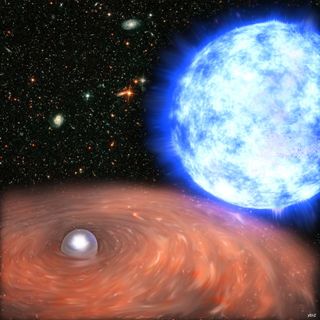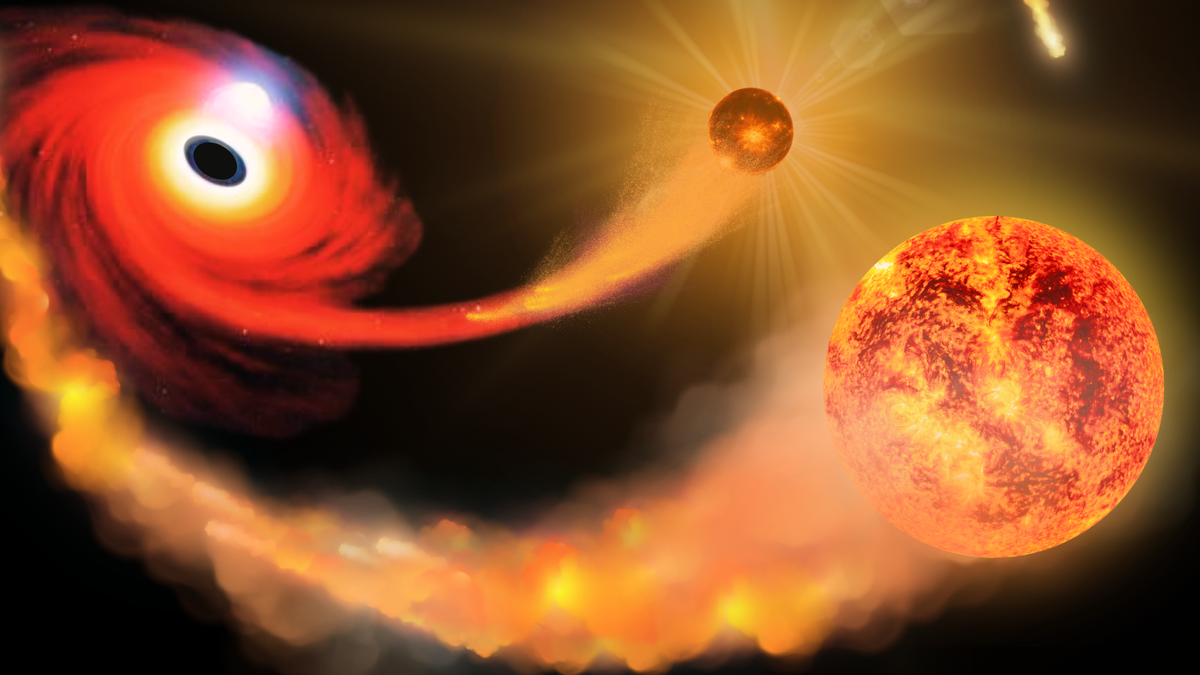Imagine eating as much as you can handle, getting heavier and heavier — all while getting slimmer and slimmer. Sounds like a dream, especially after the festive period, right? Well, maybe not for everything in the cosmos. Unfortunately, the "feasting diet" that one dead star is engaged in signals its relatively imminent destruction in a violent supernova explosion. It's the definition of "no pain, no gain."
The rapid spin of this white dwarf, that is vampirically taking stellar matter away from a companion star, could be explained by its shrinking radius. While the white dwarf won't erupt in a supernova within our lifetime, it will explode relatively soon in cosmic terms.
The white dwarf, or dead star, in question is the compact companion of the star HD 49798, which is located around 1,700 light-years away from Earth with a mass around 1.5 times that of the sun. Astronomers have been hunting for this mysterious object since 1997, when it was found to be emitting X-rays. In 2009, the European Space Agency's orbiting X-ray telescope dubbed XMM-Newton discovered that the object is indeed a white dwarf, designating it RX J0648.0–4418.
RX J0648.0–4418 has a mass around 1.2 times the mass of the sun and is the fastest-spinning white dwarf ever seen, rotating once every 13 seconds or so. This is almost twice as fast as the second-fastest spinning white dwarf, LAMOST J0240+1952, which rotates once every 25 seconds. The rotation of RX J0648.0–4418 is so rapid that it can't be explained by its voracious feeding alone.
A new analysis by National Institute of Astrophysics (INAF) researcher Sandro Mereghetti confirmed that the key to the speed of this vampire star could be the fact that it is shrinking.
"The most puzzling aspect is the spin-up rate of the accreting compact object. This is difficult to explain, given the low rate of accreted mass and angular momentum," Mereghetti told Space.com.
It isn't just the speed of RX J0648.0–4418 that makes this system extraordinary, however. This system is also the only X-ray light-emitting binary that features a white dwarf stripping stellar material from a highly evolved, helium-burning, hot subdwarf star.
"This system is quite different from all the other X-ray binaries we know: none of them has a hot subdwarf shedding mass onto a white dwarf," Mereghetti said. "This is probably a short-lived stage in the evolution of binaries, and this could explain the rarity of similar systems."
Cosmic vampires and ice skaters
White dwarfs are born when stars with masses up to around eight times the mass of the sun run out of the fuel supply they need for nuclear fusion in their cores. This ends the outward flow of energy that supports the star against its own gravity. The star's core collapses as the outer layers swell up and are eventually lost, taking with them the vast majority of the star's mass.
While this will result in a lonely death for some stars like the sun, which will undergo this process in around 5 billion years, white dwarfs with stellar companions can spring back to life by feeding on their partner stars. This feeding can increase the rotational speed, or "spin up," of feeding white dwarfs.
"White dwarfs in binaries accrete matter from the companion star. This flow of matter forms an accretion disk around the white dwarf," Mereghetti said. "The inner edge of the disk rotates faster than the white dwarf, which means the matter that settles onto the white dwarf's surface produces a torque that spins up the star."

This means it does not only matter that the white dwarf accretes, but the associated angular momentum matters as well when considering white dwarf spin rates. Still, this isn't enough to explain how fast this particular white dwarf spins.
"There is a well-known relationship between the accretion rate of mass and angular momentum," Mereghetti added. "That means, for a given accretion rate, we can estimate how fast a white dwarf would spin up. The accretion rate in HD49798 has been estimated quite well from its X-ray luminosity, which also depends on accretion rate, and it turns out that it is insufficient to produce the measured spin-up."
The speed of this dead star's rotation can be explained if the moment of inertia of the white dwarf decreases with time as the white dwarf contracts. A very similar thing happens here on Earth (albeit on a much smaller scale) when a spinning skater brings in their arms to rotate faster.
"White dwarfs slowly shrink during the first millions of years of their life," Mereghetti said. "This causes a change in moment of inertia that can explain the measured spin-up of this white dwarf."
While other white dwarf binary systems we have observed are billions of years old, this one is just a few million years old. That may be why scientists have been able to observe this white dwarf as it is contracting.
And, speaking of the lives of white dwarfs, this one may have a short life indeed.
When will this white dwarf explode?
RX J0648.0–4418 isn't just the fastest-spinning white dwarf ever detected; it is also one of the most massive even found by humanity.
And that relates to its expected lifespan.
Most white dwarfs we have discovered are around 0.6 times the mass of the sun — but this one has twice that mass. This is significant, as it means this white dwarf is very close to the so-called Chandrasekhar limit of 1.4 solar masses.
At the Chandrasekhar limit, a stellar body has enough mass to go supernova.

"There is a limiting mass that a white dwarf can sustain. It is about 1.4 solar masses. The white dwarf in this system is already quite close to this limit, and it is accreting mass," Mereghetti said. "Theoretical computations give slightly different estimates of when this system will go supernova, but all are shorter than 100 thousand years."
If this sounds like an exceptionally long time, well, it is in terms of our own lifespans — but consider that our middle-aged sun is around 4.6 billion years old.
"100 thousand years is a very short time in astronomical terms," Mereghetti confirmed.
The supernova destruction of this white dwarf will be accelerated by the fact that as this system ages, the speed at which it vampirically steals matter from its companion will increase due to the evolution of its victim, or donor, star.
"The donor is now in an evolutionary stage of helium burning in which it emits a tenuous wind, from which the white dwarf accretes matter," Mereghetti said. "But this helium-burning star will expand at the end of this stage, and its outer layers will then feel a much stronger gravity pull from the white dwarf."
Before it goes boom, there is much to learn about the HD 49798/RX J0648.0-4418 binary. Mereghetti, who was part of the team that discovered the true nature of this system 16 years ago, will continue to unlock its mysteries.
"Many aspects of the X-ray emission from this binary are not very well understood, partly due to the uniqueness of this system," Mereghetti said. "X-ray observations with future more sensitive instruments will help."
Mereghetti's research is published in a pre-peer-reviewed paper on the repository site arXiv.
.png)
 6 hours ago
4
6 hours ago
4



































 Bengali (BD) ·
Bengali (BD) ·  English (US) ·
English (US) ·